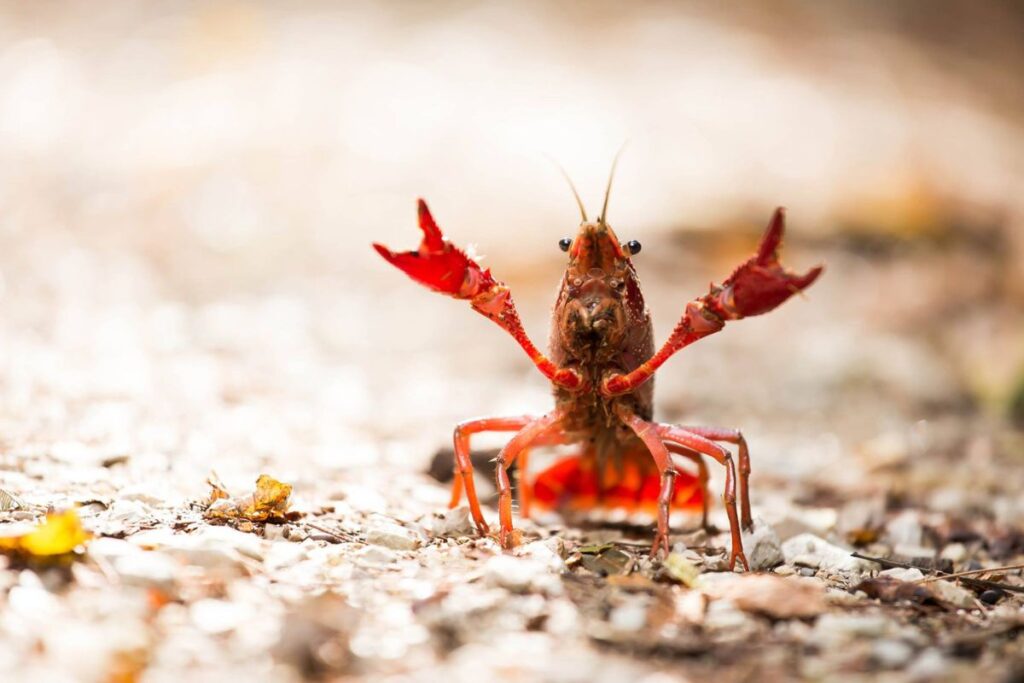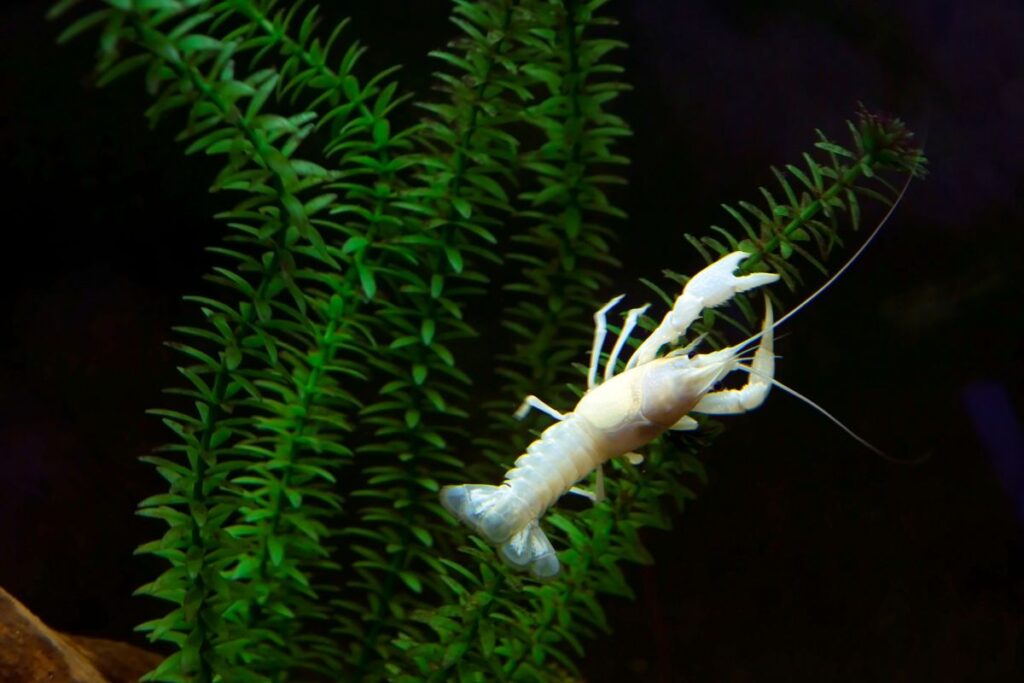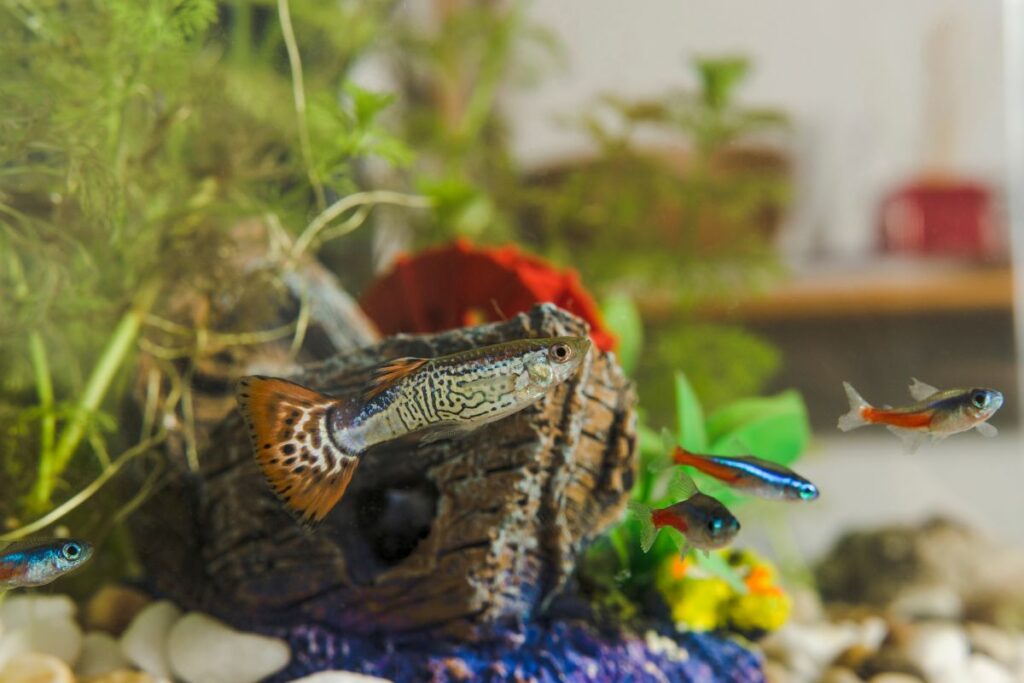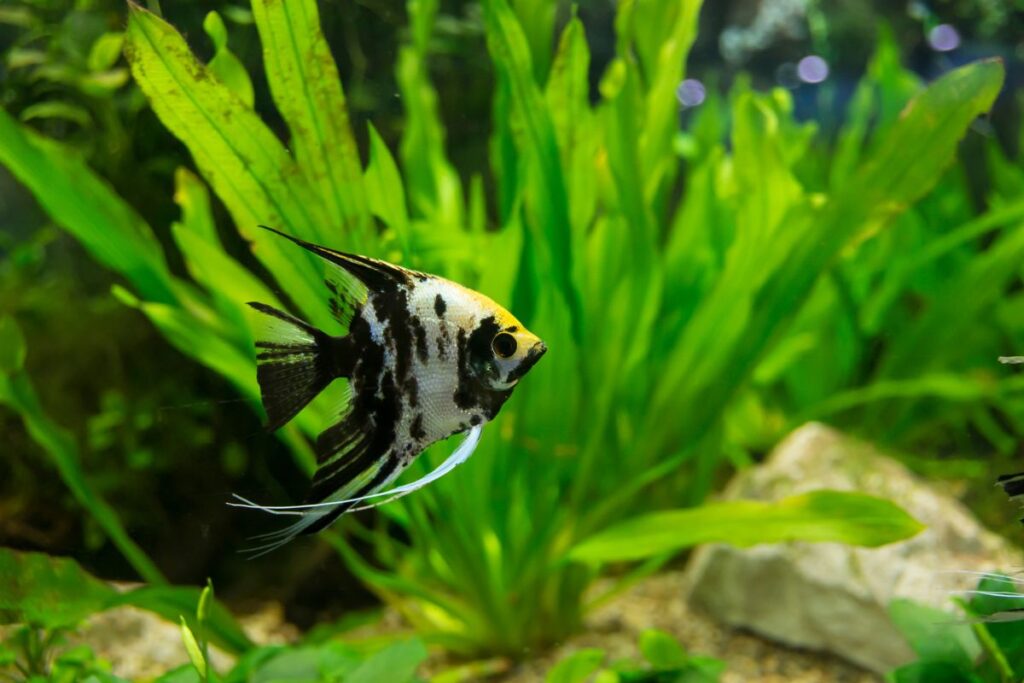If you’re looking for an interesting and unique addition to your aquarium, dwarf crayfish might be just what you need. These small crustaceans are easy to care for and can add a lot of personality to your tank. In this article, we’ll cover everything you need to know about dwarf crayfish care, from tank setup to feeding and breeding.
Dwarf Crayfish is a freshwater crustacean species that requires a minimum tank size of 5 gallons. They prefer a pH range of 6.5-8.0 and moderately hard water. They are omnivorous and should be fed a varied diet of algae, biofilm, and prepared foods. Regular water changes and proper filtration are necessary for their well-being.
First things first: when it comes to dwarf crayfish, you’ll need to make sure you have the right tank setup. These creatures are relatively small, so you won’t need a huge aquarium, but you will need to provide them with plenty of hiding places and areas to explore. You’ll also need to make sure the water temperature and pH levels are appropriate for their needs.
One thing to keep in mind is that dwarf crayfish can be territorial, so you’ll want to make sure you don’t overcrowd your tank. It’s also a good idea to provide them with plenty of plants and other decorations to create a natural-looking environment. With the right setup, your dwarf crayfish will be happy and healthy in their new home.

Table of Contents
Species Summary
If you’re looking for a unique and interesting addition to your aquarium, dwarf crayfish might be just what you need.
These tiny crustaceans are fascinating to watch and relatively easy to care for. Here’s what you need to know:
Origin
Dwarf crayfish are native to North America, where they can be found in streams, rivers, and other bodies of freshwater.
They have also been introduced to other parts of the world, including Europe and Asia.
Lifespan
On average, dwarf crayfish can live for up to 2-3 years in captivity.
However, with proper care, some individuals have been known to live for up to 5 years.
Appearance
Dwarf crayfish are small, usually growing to no more than 2 inches in length. They come in a variety of colors, including red, orange, blue, and green.
Their bodies are covered in a hard exoskeleton, which protects them from predators.
Size
As mentioned, dwarf crayfish are small creatures.
They typically grow to be between 1-2 inches in length, making them an excellent choice for smaller aquariums.
Growth Rate
The growth rate of dwarf crayfish can vary depending on a number of factors, including water temperature, diet, and overall health.
However, they typically reach their full size within 6-8 months.
Behavior & Temperament
Dwarf crayfish are generally peaceful creatures, but they can be territorial towards other crayfish.
They are also known to be excellent scavengers, helping to keep your aquarium clean by eating leftover food and debris.
Male vs Female
It can be difficult to tell the difference between male and female dwarf crayfish, but there are a few key characteristics to look for.
Males tend to have larger claws and a more elongated body, while females are typically smaller and more rounded.
Personally, I’ve found that dwarf crayfish are fascinating creatures to watch.
They’re always on the move, and their bright colors make them stand out in any aquarium.
Plus, they’re relatively easy to care for, making them a great choice for both beginners and experienced aquarists.
Tank Setup
When it comes to setting up a tank for your dwarf crayfish, there are a few key factors to keep in mind.
By providing the right environment, you can ensure that your crayfish will thrive and live a long, healthy life. Here are some important considerations to keep in mind:
Tank Size
The first thing to consider when setting up your dwarf crayfish tank is the size of the tank. While dwarf crayfish are small, they still need plenty of room to move around and explore.
A good rule of thumb is to provide at least 5 gallons of water per crayfish. This will give them enough space to move around and establish their own territory.
Lighting
Lighting is also an important consideration when setting up your dwarf crayfish tank.
While crayfish don’t require a lot of light, it’s still important to provide some light to help promote plant growth and to help you see your crayfish.
A simple LED light can be a great option for providing just the right amount of light.
Filtration & Aeration
Filtration and aeration are also important considerations when setting up your dwarf crayfish tank.
A good filter will help keep the water clean and clear, while aeration will help provide oxygen to your crayfish.
A simple sponge filter can be a great option for a dwarf crayfish tank.
Heater
Dwarf crayfish are sensitive to temperature changes, so it’s important to provide a heater to keep the water at a consistent temperature.
A good rule of thumb is to keep the water temperature between 72 and 78 degrees Fahrenheit.
Substrate
When it comes to substrate, a fine sand or gravel is a good option for dwarf crayfish. This will provide a good surface for them to walk on and explore.
Decoration
Decorations are an important part of any aquarium, and a dwarf crayfish tank is no exception.
Providing plenty of hiding places and decorations can help your crayfish feel more comfortable and secure in their environment.
Plants
Finally, live plants can be a great addition to a dwarf crayfish tank.
Not only do they help provide oxygen to the water, but they also provide a natural hiding place for your crayfish.
Just be sure to choose plants that are compatible with your crayfish and won’t be eaten or uprooted.

Overall, setting up a tank for your dwarf crayfish is a fun and rewarding experience.
By keeping these key factors in mind, you can create the perfect environment for your crayfish to thrive.
I personally love watching my crayfish explore their tank and interact with their surroundings.
Water Quality
When it comes to caring for your dwarf crayfish, water quality is one of the most important factors to keep in mind.
In this section, we’ll cover the key aspects of water quality that you need to be aware of.
Water Temperature
The ideal water temperature for dwarf crayfish is between 72-78°F (22-25°C). Make sure to use a reliable thermometer to monitor the water temperature regularly.
If the water temperature is too low, your crayfish may become sluggish and inactive.
On the other hand, if the water temperature is too high, it can cause stress and even death.
Water pH
The optimal pH range for dwarf crayfish is between 7.0-8.0.
It’s important to maintain a stable pH level, as fluctuations can cause stress and health issues for your crayfish.
You can use pH testing kits to monitor the pH level, and adjust it as needed using pH buffers or other treatments.
Water Hardness
Dwarf crayfish prefer moderately hard water with a hardness level of 6-10 dKH. If the water is too soft, it can cause molting problems and other health issues.
If the water is too hard, it can lead to mineral buildup and other complications.
You can monitor water hardness using testing kits, and adjust it as needed using water conditioners or other treatments.
Water Changes
Regular water changes are crucial for maintaining good water quality for your dwarf crayfish. Aim to change 20-30% of the water in your tank every 1-2 weeks. This will help remove excess nutrients, waste, and other contaminants that can harm your crayfish. Make sure to use a dechlorinator to treat tap water before adding it to your tank.
Personally, I’ve found that keeping up with regular water changes is one of the most important things you can do to ensure the health and happiness of your dwarf crayfish. By maintaining good water quality, you’ll be able to keep your crayfish thriving and active for years to come.
Tank Maintenance
Maintaining your dwarf crayfish tank is crucial for the health and longevity of your crustaceans. Here are a few tips to keep your tank in tip-top shape:
First, perform regular water changes to keep the water clean and clear. Aim to change 10-20% of the water every week to remove any excess waste or debris.
Second, clean the substrate at least once a month.
Use a siphon to remove any uneaten food or waste that has settled on the bottom of the tank.
This will prevent the buildup of harmful bacteria and keep the water quality high.
Third, check the filter regularly to ensure it is functioning properly. A clogged or dirty filter can lead to poor water quality and harm your dwarf crayfish.
Finally, keep an eye on the temperature and pH levels of the water.
Dwarf crayfish thrive in water that is slightly acidic with a pH between 6.5-7.5 and a temperature between 72-78°F.
Personally, I found that setting a reminder on my phone to perform weekly water changes and substrate cleanings helped me stay on top of tank maintenance.
By taking the time to care for your dwarf crayfish tank, you’ll be rewarded with healthy and happy crustaceans.
Tank Mates
When it comes to keeping dwarf crayfish, choosing the right tank mates is crucial.
Not all fish species are compatible with these small crustaceans, and some can even be dangerous.
Compatible Fish Species
If you want to keep your dwarf crayfish with fish, there are a few species that are known to be compatible.

Small, peaceful fish like neon tetras, guppies, and endlers can make good tank mates for dwarf crayfish.
These fish are unlikely to bother the crayfish, and they won’t be seen as prey.
Another option is to keep your dwarf crayfish with other invertebrates.
Shrimp, snails, and other small crustaceans can make great companions for dwarf crayfish.
They won’t compete for food, and they won’t be seen as a threat.
Incompatible Fish Species
On the other hand, there are some fish species that should be avoided when keeping dwarf crayfish.
Large, aggressive fish like cichlids, angelfish, and bettas can be a danger to crayfish. These fish may see the crayfish as prey or may attack them out of aggression.

You should also avoid keeping any fish that are known to nip at fins or harass other tank mates. These fish can stress out your dwarf crayfish and may cause them harm.
Can Dwarf Crayfish Live Together?
While dwarf crayfish can be kept with other invertebrates and some fish species, it’s generally not recommended to keep them together with other dwarf crayfish.
These crustaceans can be territorial and may fight with each other if they feel their space is being invaded.
However, if you have a large enough tank and provide plenty of hiding places and territories, it may be possible to keep multiple dwarf crayfish together. Just be sure to keep a close eye on them and separate any that show signs of aggression.
Personally, I’ve had success keeping my dwarf crayfish with neon tetras and cherry shrimp. They all get along well and create a beautiful display in my tank.
Diet
Proper diet is essential to keep your dwarf crayfish healthy and happy. In this section, we’ll cover what to feed your crayfish, how often to feed them, and some tips to keep in mind.
What To Feed
Dwarf crayfish are omnivores, which means they eat both plant and animal matter. You can feed them a variety of foods, including:
- Commercial crayfish pellets
- Algae wafers
- Frozen or live brine shrimp
- Blanched vegetables like zucchini, spinach, and carrots
- Small pieces of cooked meat or fish
Make sure to vary their diet to ensure they receive all the necessary nutrients.
Frequency
You should feed your dwarf crayfish once a day, or every other day.
Overfeeding can lead to health problems, so it’s important to avoid giving them too much food.
A good rule of thumb is to only give them as much as they can eat in a few minutes.
Tips
Here are some tips to keep in mind when feeding your dwarf crayfish:
- Remove any uneaten food after a few hours to prevent it from spoiling and polluting the water.
- Provide a variety of foods to keep your crayfish interested and healthy.
- Consider using a feeding dish or clip to keep food contained and prevent it from getting scattered throughout the tank.
I’ve found that my dwarf crayfish particularly enjoy brine shrimp and blanched vegetables. Experiment with different foods to see what your crayfish likes best!
Common Diseases
When it comes to caring for your dwarf crayfish, it is important to be aware of the common diseases that can affect them. By knowing the signs and symptoms, you can take action quickly to prevent serious health issues.
Diseases
There are several diseases that can affect dwarf crayfish, including:
- Shell rot: This is a bacterial infection that can cause the shell to become discolored and deteriorate.
- Fungal infections: These can cause white or gray patches on the shell or body.
- Parasites: Parasites can cause a variety of symptoms, including lethargy, loss of appetite, and abnormal behavior.
Symptoms
It is important to be able to recognize the symptoms of disease in your dwarf crayfish. Some common signs include:
- Changes in behavior, such as lethargy or lack of appetite
- Visible signs of illness, such as discoloration or lesions on the shell or body
- Abnormal swimming or movement patterns
Treatment
If you suspect that your dwarf crayfish is sick, it is important to take action quickly. Treatment may involve:
- Antibiotics or other medications to treat bacterial or fungal infections
- Parasite treatments
- Isolating the affected crayfish to prevent the spread of disease
Prevention
The best way to prevent disease in your dwarf crayfish is to maintain a clean and healthy environment. Some tips for prevention include:
- Regular water changes to maintain water quality
- Keeping the tank clean and free of debris
- Quarantining new crayfish before introducing them to your tank
Personally, I have found that regular water changes and keeping the tank clean have been the most effective ways to prevent disease in my dwarf crayfish. By staying vigilant and taking action quickly if you suspect a problem, you can help ensure the health and happiness of your beloved pets.
Signs of a Healthy Dwarf Crayfish
When it comes to caring for your dwarf crayfish, it’s important to know what signs to look for to ensure they are healthy and happy. Here are a few things to keep an eye out for:
- Active Movement: A healthy dwarf crayfish will be active and move around the tank frequently. If you notice your crayfish hiding in one spot for extended periods of time, it could be a sign of illness or stress.
- Bright Coloration: A healthy dwarf crayfish will have bright and vibrant colors. If you notice your crayfish’s colors are dull or faded, it could be a sign of poor water quality or an unhealthy diet.
- Smooth Shell: A healthy dwarf crayfish will have a smooth and intact shell. If you notice any cracks or holes in their shell, it could be a sign of illness or injury.
- Healthy Appetite: A healthy dwarf crayfish will have a good appetite and eagerly eat their food. If you notice your crayfish isn’t eating or has a decreased appetite, it could be a sign of illness or stress.
As a personal anecdote, I remember when I first got my dwarf crayfish, I was worried about their health and wanted to make sure they were happy in their new home. I made sure to keep an eye out for these signs of a healthy crayfish and was relieved to see my little guy swimming around actively and enjoying their food.
By keeping a close eye on your dwarf crayfish and providing them with proper care, you can ensure they live a happy and healthy life in your tank.
Signs Your Dwarf Crayfish is Sick
If you’re a new owner of a dwarf crayfish, it can be tough to tell when your little crustacean isn’t feeling well. Here are a few signs to watch out for:
- Changes in behavior: If your dwarf crayfish is suddenly hiding all the time or isn’t as active as usual, it could be a sign that something is wrong.
- Discoloration: If your crayfish’s shell is looking dull or faded, it could be a sign of poor health.
- Loss of appetite: If your crayfish isn’t eating like it used to, it could be a sign of illness.
- Strange growths or spots: If you notice any unusual growths or spots on your crayfish’s body, it’s best to get it checked out by a veterinarian.
It’s important to note that some of these symptoms can also be signs of stress or poor water quality. That’s why it’s crucial to maintain a clean and healthy environment for your dwarf crayfish.
Personal anecdote: I once noticed that my dwarf crayfish wasn’t as active as usual and wasn’t eating much. I took a closer look and noticed that its shell was looking a bit dull. I immediately tested the water quality and found that the ammonia levels were too high. After doing a water change and adding some beneficial bacteria, my crayfish perked up and started acting like its usual self again.
Breeding
Breeding Setup
To breed dwarf crayfish, you’ll need to set up a breeding tank. A 10-gallon tank is sufficient for breeding a small group of crayfish.
The tank should have a sponge filter to keep the water clean and a heater to maintain a temperature of 70-75°F. You’ll also need to provide hiding places for the crayfish, such as PVC pipes or rocks.
How To Breed
To breed dwarf crayfish, you’ll need a male and a female. The male will have larger claws than the female. Place the male and female in the breeding tank and provide them with food, such as algae wafers or shrimp pellets.
The female will carry the eggs under her tail until they hatch, which can take up to six weeks.
Care
Once the eggs hatch, the baby crayfish will need to be fed small amounts of food several times a day. Crushed algae wafers or baby shrimp pellets work well.
Make sure to keep the water clean and maintain the temperature between 70-75°F. The baby crayfish will grow quickly and will need to be separated into their own tank once they reach a size of 1 inch.
I remember when I first bred dwarf crayfish, I was so excited to see the tiny babies hatch from their eggs. It was amazing to watch them grow and develop into their own unique personalities.
If you’re patient and provide the right setup and care, breeding dwarf crayfish can be a rewarding experience.
Product recommendations for Dwarf Crayfish:
- Hikari Algae Wafers – This is a high-quality shrimp and crayfish food that is perfect for Dwarf Crayfish. It contains all the essential nutrients that your crayfish need to stay healthy and vibrant.
- API Aquarium Test Kit – It is important to keep an eye on the water quality in your aquarium, and this test kit makes it easy to do so. It includes tests for ammonia, nitrite, nitrate, and pH.
- Seachem Prime – This is a water conditioner that helps to detoxify ammonia, nitrite, and nitrate in your aquarium. It is safe for use with Dwarf Crayfish and other freshwater fish.
- CaribSea Eco-Complete Planted Aquarium Substrate – This substrate is perfect for creating a natural environment for your Dwarf Crayfish. It contains live bacteria and is easy to maintain.
- AquaClear Power Filter – This filter is highly effective at removing debris and maintaining water quality in your aquarium. It is also very quiet and easy to maintain.
- Aqueon Aquarium Water Changer – This device makes it easy to perform regular water changes in your aquarium. It is designed to be safe and easy to use, and can help to keep your Dwarf Crayfish healthy.
- Zoo Med Nano 10 External Canister Filter – This is a small and efficient filter that is perfect for smaller aquariums housing Dwarf Crayfish. It is easy to install and maintain, and will keep the water in your aquarium clean and healthy.
- NICREW ClassicLED Aquarium Light– This LED light is perfect for illuminating your aquarium and showcasing your Dwarf Crayfish. It is energy-efficient and easy to install.
- Marimo Moss Balls – These are a great addition to any shrimp or crayfish tank, including one housing Dwarf Crayfish. They provide a natural habitat for your crayfish and help to maintain water quality.
Conclusion
Now you know everything you need to know about caring for dwarf crayfish! Remember to keep their tank clean, provide them with plenty of hiding spaces, and feed them a balanced diet. With a little bit of effort, these tiny crustaceans can thrive in your aquarium.
Don’t forget to monitor the water parameters regularly and make adjustments as needed. Keep an eye out for any signs of illness or stress, and take action promptly if you notice anything amiss.
If you’re new to keeping dwarf crayfish, don’t be intimidated. With a little bit of research and patience, you can provide a happy and healthy home for these fascinating creatures. And who knows, you may even find yourself becoming a bit of a crayfish enthusiast!
Personally, I was hesitant to add dwarf crayfish to my tank at first. But after doing some research and watching them scuttle around, I’ve grown to love these little guys. They add a unique and interesting element to my aquarium, and I enjoy watching them interact with each other and explore their surroundings.
FAQs
When it comes to taking care of dwarf crayfish, you may have a few questions. Here are some of the most commonly asked questions and their answers:
Q: What should I feed my dwarf crayfish?
A: Dwarf crayfish are omnivores and will eat just about anything. You can feed them sinking pellets, frozen or live foods like bloodworms, brine shrimp, and daphnia. You can also give them fresh vegetables like zucchini, carrots, and spinach.
Q: Can I keep dwarf crayfish with other fish?
A: Dwarf crayfish can be kept with other peaceful fish, but it’s important to choose tank mates carefully. Avoid keeping them with aggressive or territorial fish that may harm or stress out the crayfish. Also, make sure the other fish are not too big and won’t try to eat the crayfish.
Q: How often should I clean the tank?
A: It’s important to keep the tank clean to ensure the health of your dwarf crayfish. You should do a partial water change of about 20% every week and clean the substrate and decorations as needed. Make sure to use a water conditioner to remove any harmful chemicals from the tap water.
Q: Do dwarf crayfish need a filter?
A: Yes, a filter is necessary for a healthy dwarf crayfish tank. The filter will help keep the water clean and remove any harmful chemicals or waste products. Make sure to choose a filter that is appropriate for the size of your tank and the number of crayfish you have.
Personal Anecdote: When I first got my dwarf crayfish, I was worried about what to feed them. I tried a few different types of food and found that they loved frozen bloodworms the most. Now, I make sure to always have some on hand for a special treat.
Reference: Wikipedia.
